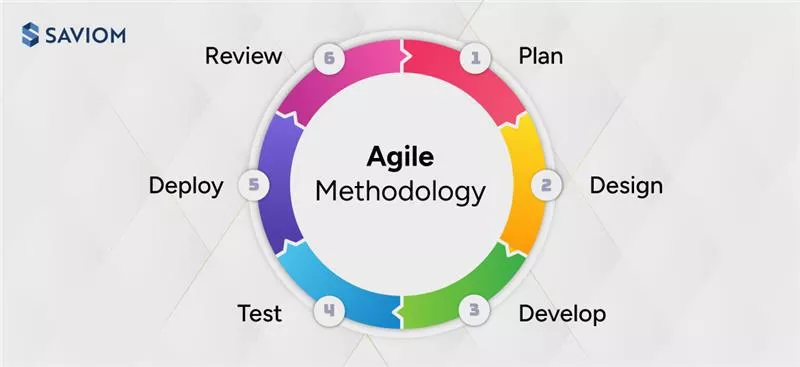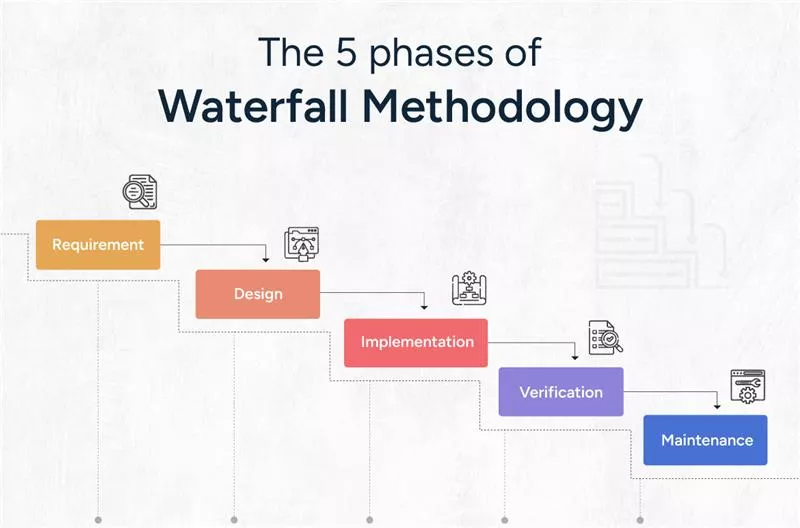Over the decades, numerous project management methodologies have emerged, each designed to address specific project needs and challenges. Among them, Agile and Waterfall stand out as two of the most widely used approaches, offering distinct frameworks for planning, execution, and delivery.
Waterfall has long been favored for its predictability and easily manageable step-by-step structure. However, Agile has gained traction for its adaptability, continuous feedback loops, and responsiveness to change. Understanding the nuanced differences between Agile vs. Waterfall is essential for choosing the right approach to drive project success.
This article weighs in on both approaches by defining them and listing their advantages, disadvantages, and differences to help you decide how to align the right process to your organization’s vision.
Let’s begin!
What is Agile Methodology?
Agile is an iterative and incremental project management approach that prioritizes continuous improvement, adaptability, and customer feedback. It enables teams to respond quickly to changing requirements and deliver value in small, manageable increments. This makes Agile methodology highly suitable for software development and other dynamic industries where flexibility is essential.
Unlike traditional project management approaches, Agile is not a single process. It is an umbrella term that includes various frameworks such as Scrum, Kanban, Lean, Extreme Programming (XP), and SAFe (Scale Agile Framework). All these frameworks share a common objective: to improve project flexibility, enhance collaboration, facilitate faster delivery, and ensure high-quality outcomes.

Agile methodology enables iterative development and continuous collaboration for flexible project management.
Now that we understand the definition of Agile methodology, let’s go over its advantages and disadvantages.
Advantages of Agile Methodology
By welcoming changes even in late development, Agile fosters continuous improvement and adaptability. Here are some additional benefits of Agile:
- Improves Flexibility & Adaptability: The Agile method allows teams to adjust project scope, priorities, and deliverables as business needs evolve, ensuring rapid responsiveness to change.
- Strengthens Collaboration & Transparency: Cross-functional teams and frequent stakeholder interactions keep everyone abreast of project progress at every stage.
- Enhances Customer Satisfaction: Continuous feedback ensures that the project yields tangible outcomes, and that the final product aligns with user needs and expectations.
- Increases Efficiency & Productivity: Agile reduces delays by breaking work into smaller steps, allowing continuous feedback, and keeping teams focused on high-priority tasks from the product backlog.
- Fosters Early Risk Identification & Mitigation: Frequent testing and sprint reviews help detect and address issues before they escalate, preventing costly delays and other project risks like scope creep, resource shortage, etc.
- Ensures Continuous Improvement & High-Quality: Agile promotes ongoing learning, iterative refinement, and frequent testing for consistent enhancements in product quality and process optimization.
- Facilitates Faster Delivery & Time to Market: Breaking projects into smaller increments enables quicker releases, faster feedback, and early value delivery, ensuring faster adaptation to market demands.
Now, let’s us quickly take a look into cons of Agile framework.
Disadvantages of Agile Methodology
While Agile is highly effective, it also comes with challenges like evolving requirements, stakeholder dependence, and scope management issues. Here are some key disadvantages:
- Ambiguous Role Definition: The Agile method’s fluid structure can sometimes lead to confusion regarding roles and responsibilities, especially for teams that transition from a rigid framework to this flexible style.
- Unclear Timelines & Budgets: The evolving requirement of the Agile method makes it difficult to establish fixed timelines and budgets, leading to challenges in accurately forecasting project costs and delivery schedules.
- Heavy Stakeholder Dependency: Agile relies on continuous stakeholder engagement for feedback. If key stakeholders are unavailable or there is a lack of involvement, it can slow down decision-making, affecting project progress.
- Difficulty in Scope Management: Frequent changes in requirements can lead to uncontrolled scope expansion, resulting in scope creep, budget overruns, and project delays/
- Limited Suitability for Large-Scale Projects: Agile is less effective for projects with rigid requirements, fixed deadlines, or interdependent components, where structured planning is crucial.
- Lack of Detailed Documentation: Agile prioritizes working solutions over comprehensive documentation, which can create challenges in maintaining project history, onboarding new team members, or ensuring clarity in long-term projects.
- High Risk of Team Burnout: Timeboxed events, continuous iterations, and evolving requirements can create stress and fatigue among team members, especially when managing multiple projects simultaneously.
As we are now aware of the pros and cons of Agile project management, let’s understand what Waterfall methodology is.
Read More: What is Agile Project Management & How to Effectively Manage Resources?
What is Waterfall Methodology?
Waterfall methodology is a structured, linear project management approach where progress flows through predefined stages. Each phase, such as requirements gathering, design, development, testing, and deployment, must be completed before moving to the next. This makes it ideal for projects with fixed requirements, well-defined objectives, and minimal scope for change.
Waterfall is a documentation-driven approach that emphasizes rigorous planning, detailed requirement analysis, and thorough risk assessment before development begins. This enables project teams to set clear timelines, allocate resources efficiently, and mitigate risks proactively. As a result, project milestones are achieved on time, reducing uncertainties and maintaining overall stability.

Waterfall methodology follows a structured, sequential approach for streamlined project execution.
Now that we have a clear understanding of the Waterfall methodology, let’s explore its advantages and disadvantages.
Advantages of Waterfall Methodology
Waterfall’s structured approach ensures clarity and predictability, making it ideal for projects with well-defined requirements. Here are its key advantages:
- Clear & Structured Project Roadmap: Waterfall follows a linear, sequential approach, ensuring a well-defined roadmap that makes project planning, resource allocation, and execution more efficient.
- Ensures Stable Timelines, Budgets, and Scope: Since requirements are defined upfront in the Waterfall method, project timelines, budgets, and scope remain stable, reducing uncertainty and enabling accurate forecasting.
- Promotes Process-Oriented Framework: Waterfall relies on a structured process rather than individual team members, ensuring continuity and smooth project execution even when resources change.
- Facilitates Comprehensive Documentation: Extensive documentation at every phase provides clear guidelines for future updates, maintenance, and onboarding of new team members.
- Fosters Effective Dependency Management: Clearly defined project phases help teams identify dependencies early, minimizing risks such as resource shortage or scope creep and ensuring smooth workflow transitions between stages.
- Provides Milestone-Based Tracking: Waterfall projects follow clearly defined milestones, making it easier to measure progress, track deliverables, and ensure the timely completion of each phase.
- Lowers Risk of Scope Creep: Fixed project scope reduces unplanned changes, preventing unnecessary delays, cost overruns, and deviation from the original objectives.
- Helps Limit Client Involvement: Waterfall requires client input mainly for reviews, approvals, and status updates, reducing the need for constant engagement and workflow disruptions.
- Well-Defined Testing & Quality Assurance Process: In Waterfall, testing is conducted in a structured manner after development, ensuring thorough validation, defect identification, and adherence to quality standards before deployment.
Read More: Understanding Scrum vs. Waterfall: Pros, Cons, and How to Choose the Best One
Disadvantages of Waterfall Methodology
While Waterfall provides structure and predictability, its rigid framework can present challenges in dynamic environments. Here are some key drawbacks:
- Assumption of Fixed Requirements: In the Waterfall method, it is assumed that clients know exactly what they need from the start, which may not always be true. The requirements might change with evolving business priorities.
- Limited Flexibility & Adaptability: Waterfall’s rigid structure makes changes difficult after the requirements analysis phase, leading to extensive replanning, delays, and increased costs.
- High Risk of Rework & Resource Wastage: Since the project follows a sequential process in Waterfall, errors or misunderstandings in earlier stages may only be identified later, resulting in costly rework.
- Minimal Client & End-User Involvement: Clients typically provide input during the initial stages and see the final product at the end in this method, increasing the risk of misalignment with expectations and user needs.
- Delayed Testing & Quality Assurance: Testing occurs only after the development phase is completed, which may lead to late discovery of defects, requiring extensive fixes and adjustments.
- Extended Timelines & Slow Delivery: Since each phase must be completed before moving to the next, Waterfall projects tend to have longer timelines, delaying the time-to-market and early value realization.
As we now know the benefits and limitations of Waterfall project management, let’s explore some examples.
Read More: Top 10 Project Management Trends of 2025 to Stay Ahead of the Curve
Examples of Agile and Waterfall
Below are practical examples showcasing how Agile vs. Waterfall methodologies are applied in real-world scenarios. These illustrate their approach and suitability for different project types.
Example of Agile Methodology
Consider an IT company developing a new mobile application for personal finance management that enables expense tracking and offers AI-driven financial insights. To ensure flexibility, the team follows a scrum-based Agile methodology, aiming to complete the project within five months. The project is divided into five sprints, each lasting four weeks. The development process might proceed as follows:
Sprint 1: Planning
The team begins by identifying user needs, researching the market, and defining the initial product backlog. Developers set up the architecture, ensuring it is scalable and secure for future updates. The UI/UX team designs wireframes and mockups for an intuitive user experience.
Sprint 2: Development
Developers start working on the user interface, ensuring a simple and user-friendly design. For that, key features like user login, account linking, and expense tracking are developed. At the end of the sprint, the project manager reviews progress and updates the product backlog based on stakeholder feedback.
Sprint 3: AI Integration and Security
In this sprint, AI-driven budgeting suggestions and automated expense categorization are introduced. It allows the app to analyze spending patterns to provide financial forecasts. Moreover, security measures, including multi-factor authentication, are strengthened, and the backlog is refined to address new priorities.
Sprint 4: Testing and Optimization
This sprint focuses on optimizing speed, fixing bugs, and refining the user experience. For that, the team tests a beta version with selected users and incorporates the feedback. Additionally, security and encryption measures are further improved, and the backlog is updated for the final sprint.
Sprint 5: Deployment
Here, developers make final refinements, ensuring all features function smoothly. Meanwhile, the marketing team prepares for the application launch. Any last-minute issues are also resolved before releasing the app on major platforms.
Throughout the project, the team holds daily stand-up meetings to track progress and resolve any blockers, ensuring smooth development. Moreover, sprint reviews provide an opportunity for stakeholders to assess completed work, offer feedback, and refine the product backlog.
Read More: Top 12 IT Project Risks: Effective Ways to Mitigate Them
Example of Waterfall Methodology
Consider a construction company planning to build a new office complex. Given that the construction project has clearly defined objectives, fixed requirements, and strict regulatory standards, the company opts for the Waterfall methodology to ensure a structured approach. The project may progress through the following sequential phases:
Requirements Gathering
In this phase, the team collaborates with stakeholders to define the project’s scope, including the number of floors, office spaces, facilities, and design preferences. This phase ensures that a detailed project timeline and resource allocation plan are created.
Design
Next, architects and engineers create detailed blueprints and structural plans based on the gathered requirements. This includes site layout, building materials, electrical systems, and plumbing. These designs serve as a comprehensive reference for the construction team.
Implementation & Construction
Here, construction teams commence building the office complex according to the approved designs, following a strict step-by-step approach. From laying the foundation to erecting the structure and installing systems, each stage follows the predetermined plan without deviation.
Verification
After construction, thorough inspections are conducted to ensure the building meets all safety regulations, quality standards, and design specifications. Following that, any identified issues are addressed before the final handover. Stakeholders review the finished project for final approval.
Maintenance
Once occupied, the building undergoes regular maintenance to uphold its functionality and safety. This phase includes routine inspections, repairs, and necessary upgrades to sustain structural integrity.
As each phase is completed, the team ensures thorough documentation, providing a clear record of progress. This helps maintain clarity and supports future maintenance, compliance checks, and renovations.
After going through the examples, it’s time to look into the differences between Agile vs. Waterfall methodologies.
Read More: Top 14 Project Management Methodologies: Tips to Choose the Right One
Key Differences Between Agile vs. Waterfall Project Management
Agile vs. Waterfall are two distinct project management approaches, each with its own strengths and challenges. The table below highlights the key differences between Agile vs. Waterfall method:
| Aspect | Agile Project Management | Waterfall Project Management |
|---|---|---|
| Team Structure | Cross-functional teams with flexible roles, allowing collaboration across different aspects of the project. | Structured teams with predefined roles and responsibilities assigned from the beginning. |
| Project Planning | Adaptive planning where requirements evolve based on continuous feedback and changing priorities. | Detailed planning at the start, with all requirements defined upfront. |
| Development Approach | Iterative development with frequent reviews and improvements. | Sequential development, where one phase must be completed before moving to the next. |
| Flexibility | Highly flexible, allowing for changes at any stage of development. | Rigid framework, making changes difficult and costly after a phase is completed. |
| Speed | Faster delivery as functional parts of the product is released in iterations. | Slower delivery as the entire project must be completed before release. |
| Change Management | Easily accommodates changes and new requirements throughout the project. | Changes after the planning phase are difficult and may disrupt the entire timeline. |
| Testing Process | Continuous testing alongside development, allowing early issue detection. | Testing occurs only after development is complete, leading to late-stage fixes. |
| Delivery Timeline | Frequent delivery of components in short iterations. | A single-phase delivery model, where the final product is released at the end. |
| Documentation | Minimal documentation focused on essential details. | Extensive documentation at each phase for future reference and maintenance. |
| Stakeholder Involvement | Active stakeholder involvement throughout the project, providing continuous feedback. | Limited stakeholder involvement, primarily during the initial planning and final review. |
| Communication Style | Frequent, informal communication with daily stand-up meetings and team collaboration. | Formal communication with scheduled meetings, milestone reviews, and detailed reports. |
After assessing the differences between Agile vs. Waterfall, let us understand how to choose the right methodology.
Read More: 10 Ways to Improve Cross-Departmental Collaboration
How to Choose the Right Methodology Between Agile vs. Waterfall?
Selecting the right project management methodology between Agile vs. Waterfall is crucial for ensuring successful project execution, efficient resource management, and budget optimization. The decision should be based on factors such as project size and complexity, skill set of resources, industry requirements, and long-term business goals.
For projects with fixed requirements, strict budgets, and regulatory constraints, Waterfall may be the best choice. It provides clear documentation, structured workflows, and predictable timelines. On the other hand, Agile works well for projects needing continuous updates, stakeholder involvement, and adaptability to change.
In addition, before deciding between Agile vs. Waterfall, firms should analyze past portfolios, engage all key project stakeholders, and assess alignment with business goals. For projects that require both structure and flexibility, a hybrid model – combining Waterfall’s predictability and Agile’s adaptability, can offer the best of both worlds.
Read More: Who are Project Stakeholders? 7 Effective Ways to Manage Them
Conclusion
Choosing between Agile vs. Waterfall depends on project requirements, team dynamics, and business goals. While Agile offers flexibility and continuous feedback, Waterfall ensures structure and predictability. Hence, understanding their strengths and limitations helps organizations make informed decisions. Ultimately, the right approach aligns with project needs, fosters efficiency, and drives successful outcomes.
So, between Agile vs. Waterfall, which methodology best suits your projects?
The Glossary
Read More: Glossary of Resource Workforce Planning, Scheduling and Management











